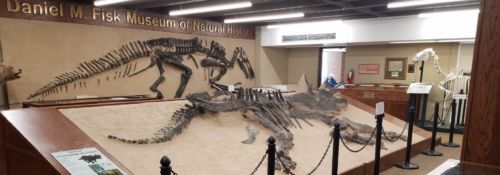
A Timely Discovery: The Daniel M. Fisk Natural History Museum
Written by Elizabeth Vietor
The first detail I noticed when I stepped inside the Daniel M. Fisk Museum of Natural History was the row of taxidermy heads along the wall. Gazelles and deer hung beside elk, reindeer, and, in the center, the huge head and antlers of a moose. It reminded me of a hunting lodge.
That is, until I looked down. Beneath the imposing row of heads lay glass display cases filled with marine life, including coral, sponges, sand dollars, and starfish so spindly that at first I thought they were bundles of dried grass (a sign informed me that these creatures are called “brittle stars”). Atop the case stretched the skin of an African rock python at least twice as long as I am.
Contrasts like this–big and small, land and marine–are common in the museum. In a classroom-sized space on the second floor of Strosacker Hall, animal specimens from the Victorian era are preserved alongside findings from the present day.
“There’s a rhyme and reason to how the museum looks,” said Dr. Tony Swinehart, curator of the museum. The brown tones of the interior and glass cases are an intentional choice meant to create a Victorian atmosphere, as if stepping into an old sepia-toned photograph. As a natural history museum, an effort was made to preserve its history and to transport the viewer back to the time when it was begun.
The Fisk Museum had a heyday early in the history of the College. It began around 1855 with the initiative of Daniel M. Fisk, the first chair of natural sciences at Hillsdale. Fisk kept the doors open through several fires and relocations, but after he left the College, the museum gradually shrank and disappeared entirely.
When Swinehart arrived at Hillsdale in 1998, the museum had been nonexistent for almost fifty years. His ability to reconstruct it arose from an unexpected discovery. While taking a last look in Knowlton Hall, an old College building awaiting demolition, Swinehart chanced upon a hidden attic room that contained thousands of specimens from the former museum. Arguably his most important discovery was an article written by Fisk from 1879, filled with specifications about the collections and layout of the museum. “The article was a blueprint of everything I needed to know about rebuilding the museum,” Swinehart said.
Under Swinehart’s direction, the museum has had a renaissance over the last twenty years and is still expanding. Walking through it was for me as much a trip through history as through science. If you haven’t been there, give it a try. You’ll witness a unique narrative of the past and present of a discipline.
 Elizabeth Vietor is a junior Latin major with an affinity for thrift shops, butter, and scrunchies. She hails from Phoenix, Arizona, originally, but now that she’s here, doesn’t know how she existed for so long without seeing the leaves change every fall.
Elizabeth Vietor is a junior Latin major with an affinity for thrift shops, butter, and scrunchies. She hails from Phoenix, Arizona, originally, but now that she’s here, doesn’t know how she existed for so long without seeing the leaves change every fall.
Published in April 2019